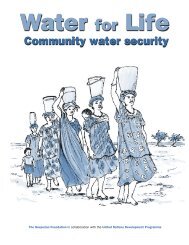Integrated Flood Management-Concept Paper.pdf - APFM
Integrated Flood Management-Concept Paper.pdf - APFM
Integrated Flood Management-Concept Paper.pdf - APFM
You also want an ePaper? Increase the reach of your titles
YUMPU automatically turns print PDFs into web optimized ePapers that Google loves.
6. PUTTING INTEGRATED<br />
FLOOD MANAGEMENT INTO PRACTICE<br />
As an integral part of <strong>Integrated</strong> Water Resources<br />
<strong>Management</strong>, <strong>Integrated</strong> <strong>Flood</strong> <strong>Management</strong> faces<br />
similar challenges. The effective implementation<br />
of both IFM and IWRM requires an enabling<br />
environment in terms of policy, legislation and<br />
information; clear institutional roles and functions;<br />
and management instruments for effective<br />
regulation, monitoring and enforcement. These<br />
requirements are a function of the specific<br />
climatic, hydrological and physical conditions<br />
of the basin coupled with cultural, political<br />
and socio-economic interactions and existing<br />
development plans for the location.<br />
Clear and Objective Policies Supported with<br />
Legislation and Regulations<br />
The nature of the flood problem creates a situation<br />
of competing claims and sometimes the need<br />
for immediate action in order to fulfil people’s<br />
aspirations, particularly just after a major flood.<br />
In such circumstances integration is often the<br />
first casualty. Thus, political commitment to IFM<br />
principles and practice is critical. The strategies<br />
developed for IFM need to be translated into<br />
specific policies for the planning, allocation and<br />
management of resources, not only in one sector<br />
such as transport or environment, but in all<br />
sectors having an influence on flood formation<br />
and management. Linking flood management<br />
with IWRM provides intersectoral linkages with<br />
social and economic development, and forms<br />
the basis for stakeholder participation. This<br />
approach may imply a substantial overhaul of<br />
policies, laws and management institutions. Clear<br />
and objective policies for the declared goals of<br />
the government, supported with appropriate<br />
legislation and regulations to enable the process<br />
of integration, are prerequisites.<br />
<strong>Integrated</strong> <strong>Flood</strong> <strong>Management</strong> seeks to develop<br />
and adopt policies that respond to long-term<br />
needs and that address themselves to both<br />
extreme and normal flood events, while providing<br />
for stakeholder participation in the process.<br />
These policy stipulations require an appropriate<br />
legislative framework defining the rights, powers<br />
and obligations of the concerned institutions and<br />
floodplain occupants. Regulations may cover<br />
such issues as floodplain zoning, the conduct of<br />
flood and severe weather forecasting and warning<br />
services, and disaster response, among others.<br />
In addition, the basic enabling environment<br />
for IWRM incorporates the principles of water<br />
and land use, requires a clear understanding of<br />
water rights and establishes the legitimacy of<br />
stakeholders. <strong>Flood</strong>-related legislation is rare,<br />
especially in developing countries, and the<br />
effective implementation of legislation requires<br />
a long-term political commitment.<br />
The Need for a Basin Approach<br />
River and lake basins are dynamic systems with<br />
complex interactions between the land and water<br />
environments (Figure 2). These interactions involve<br />
not only water but also soil, sediment, pollutants<br />
and nutrients. The system is dynamic over both<br />
time and space. The functioning of the basin as<br />
a whole is governed by the nature and extent of<br />
these interchanges.<br />
An increase in economic activities, such as mining,<br />
farming or urbanization, may result in large-scale<br />
deforestation, leading to larger sediment yields<br />
from water catchments. Landslides induced by<br />
natural or human activities in hilly areas increase<br />
sediment concentration in the rivers. The increased<br />
sediment concentration disturbs natural river<br />
regimes. While most of the sediment is carried<br />
to the sea, a large portion gets deposited in river<br />
channels thus reducing the discharge capacity of<br />
the sediment conveyance system. Over a period<br />
of years this sometimes results in some stretches<br />
of the river bed becoming raised above the surrounding<br />
floodplains, while erosion processes<br />
dominate downstream of reservoirs, as sediments<br />
are trapped by those reservoirs.<br />
Large-scale urbanization in comparatively small<br />
catchments accentuates flood peaks and reduces<br />
the time of concentration. This is because land<br />
surfaces in urbanized basins – made up of roofs,<br />
paved streets and other impervious surfaces<br />
– increase overland flow volume and decrease<br />
groundwater recharge and evapotranspiration. In<br />
lowlands and coastal areas, road and rail embankments<br />
and similar infrastructure can obstruct flood<br />
flows and exacerbate flood conditions upstream.<br />
Similarly, measures to improve navigation can<br />
21
















